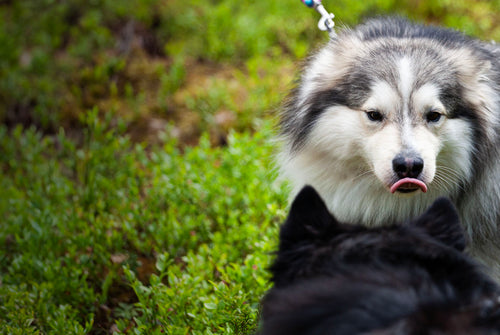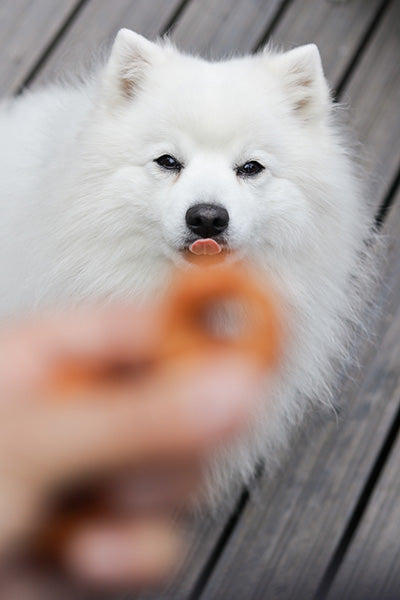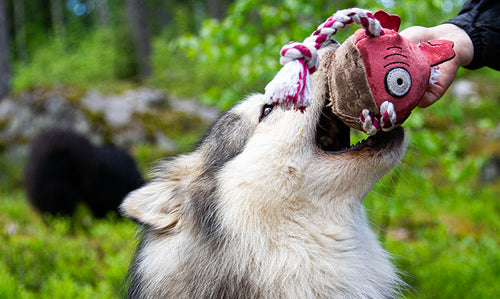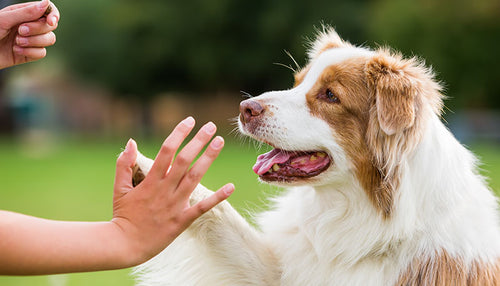

Dog Training - Why Is It Important?
Dog obedience training is a crucial part of raising and ensuring the well-being of your dog. It helps your dog learn behavioral rules that they need in various life situations. Additionally, training strengthens the bond between the dog and the owner while promoting safety.
Obedience training for dogs typically starts with basic skills. These foundational obedience skills are useful, for example, when your dog interacts with other people or animals, walks in traffic, or is at home with guests.
Once your dog has mastered the basics, you can move on to more advanced exercises. These may include recall (coming when called), loose leash walking, and managing distractions. Such skills are particularly important when your dog is off-leash during outdoor activities or needs to wait calmly—for instance, crossing a busy street.
Remember that dog training is not just about learning commands. It also involves positive reinforcement and rewarding good behavior. All of this contributes to building your dog’s trust in you and in itself.

Where to start dog obedience training?
The first step toward successful obedience training for your dog is to understand their needs and personality. Every dog is unique, so you should find the approach that works best for your own dog when learning new things. Some dogs learn quickly through positive reinforcement, while others require more time, patience and repetition.
Here are a few steps to consider, when beginning dog obedience training:
Socialization
Socializing your dog is crucial for its obedience training. Ensure that your dog gets to interact with different people, other dogs, and various environments. This helps the dog create positive experiences and learn how to behave in different situations.
Name Recognition and Rewards
Teach your dog its own name and how to respond to it. Use rewards such as dog treats or praise when the dog “responds” to the desired behavior associated with its name. This helps establish a connection between the dog and its owner.
For rewarding during training, consider using e.g. Best Friend Nordic Mini Bits treats. They are perfect training snack due to their small size and soft texture! Our selection includes a wide selection of dog treats to add pleasant variety to your training sessions and reward your furry friend.
Basic Commands
Start with basic commands such as “sit,” “down,” and “come.” Use positive reinforcement when your dog performs the desired command. Practice these commands in short and focused training sessions so that your dog associates the commands with rewards.
Leash Behavior for Your Dog
Teach your dog good leash behavior. Begin with short walks and use consistent commands and rewards when your dog walks nicely by your side. Avoid pulling or using overly forceful tugs on the leash. Allow your dog to learn proper behavior through positive reinforcement.
Advanced Training
Once the basic commands are going well, you can expand training to other skills such as recall (coming when called), staying in place, and tolerating distractions. You might also consider an obedience training course or seek professional guidance if you need additional support.
Try These Dog Training Treats
Remember that training your dog requires time, patience, and consistency. Using positive reinforcement is an effective way to train your dog and build a strong bond between owner and pet.
During training, be patient and positive. Always reward your dog when it does something right – whether with praise or dog treats – so it understands that it’s doing something good. Avoid punishment or yelling, as it can scare the dog and slow down the learning process.
Consistency is key during training. Always use the same command in the same situation, and ensure that all family members use consistent commands. This helps the dog better understand what is expected of it.
Regularly maintain your dog’s obedience training. While it requires time and commitment, the end result is worthwhile. Once your dog masters the basics, you can move on to more challenging tasks and further develop its skills.

What are the benefits of training a dog?
Training a dog has several benefits for both the dog and the owner. Here are some important advantages training brings:
Improved Communication
Training fosters better communication between the dog and its owner. As the dog learns various commands and signals, it gains a deeper understanding of the owner’s expectations and needs. This enhances cooperation and helps build a strong bond between the dog and its owner.
Safety
A trained dog is safer for both itself and its surroundings. Through training, the dog learns essential skills such as coming when called, sitting or lying down on command, and walking nicely on a leash. These abilities help prevent dangerous situations and allow better control of the dog in various contexts.
Stress Management
A trained dog can handle different situations and distractions more effectively. Training helps the dog learn calming skills, such as sitting or lying down, which aids in managing stress and anxiety. Additionally, a well-trained dog may exhibit more confidence and fewer fears when facing various scenarios.
Social Interaction
Socialized dogs are generally better at interacting with different people, other dogs, and animals. This ease of socialization makes it more convenient for the dog to participate in various situations, such as walks, visits, or trips to dog parks.
Enjoyable Bonding
Training can be enjoyable and rewarding for both the dog and the owner. Shared practice sessions and learning moments strengthen the relationship between them. Additionally, training opens up opportunities for diverse activities like agility, tracking, canine dancing etc. Exploring new hobbies with your dog can be fun and refreshing for both parties.
Training a dog requires time, patience, and consistency, but its benefits are diverse and help create a harmonious and content relationship between the dog and the owner.

What are the most common challenges in dog obedience training and how can they be overcome?
Dog obedience training is an essential part of raising a dog, as it helps teach important behavioral patterns. However, like any form of training, dog obedience training comes with its challenges. Below, you can read about the most common challenges and receive tips on overcoming them:
Lack of Motivation
One significant challenge in dog obedience training is a lack of motivation. Dogs are individuals, and their motivation to learn new things varies. While some dogs respond well to praise and treats, others require more encouragement.
The solution to this challenge is to find a reward that specifically motivates your own dog. Some dogs get excited by toys or verbal praise, while others prefer treats or the opportunity to play with others.
Remember that patience, consistency, and positive reinforcement play crucial roles in successful dog training. By understanding your dog’s unique needs and adjusting your approach accordingly, you can overcome these challenges and build a strong bond with your furry companion.
Environmental Distractions
Another common challenge in dog obedience training is environmental distractions, which can make training difficult. For example, other people or animals may tempt your dog away during practice.
To overcome this challenge, it’s essential to start dog training in a calm environment and gradually progress to environments where distractions may occur. You can use training treats or toys to capture your dog’s attention.
Too Rapid Progress
Moving too fast can also be a challenge in dog obedience training. If a dog hasn’t mastered basic commands like sitting or staying, it will struggle with more complex tasks.
The solution to this challenge is to revisit teaching fundamental skills and ensure that the dog has a solid grasp of them before moving on to more intricate exercises.
Inconsistent Training
Inconsistent training can pose difficulties as well. If a dog only practices sporadically, it will have trouble retaining what it has learned.
To overcome this challenge, regular practice and sticking to a training schedule are crucial. Training sessions should be short and intense to keep the dog motivated.
Negative Experiences
Negative experiences can also impact dog obedience training. If a dog has had unfavorable encounters during training, it may become reluctant to practice.
The solution is to use positive reinforcement and avoid punishment. Provide plenty of praise and rewards when the dog performs correctly.
Nordic Mini bits
Best Friend’s delicious training treats are suitable rewards for dog training.
Made from the finest Nordic ingredients, Best Friend Nordic Mini Bits training treats are the perfect pocket-sized snacks for your dog’s training moments! These gently baked and delightfully meaty treats, crafted from a single protein source, are sure to please even the pickiest furry friend! The assortment includes three delicious flavors: Nordic Mini Bits Chicken, Nordic Mini Bits Lamb, and Nordic Mini Bits Fish.
What could be better than a small, tasty piece of the Nordic for your dog?











